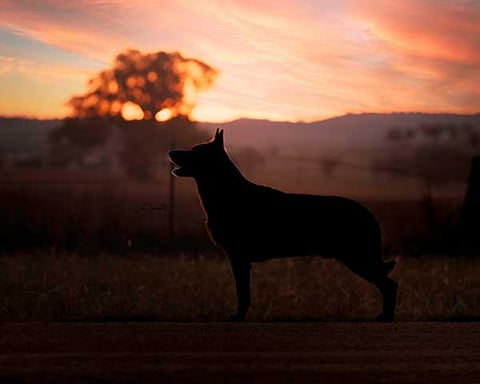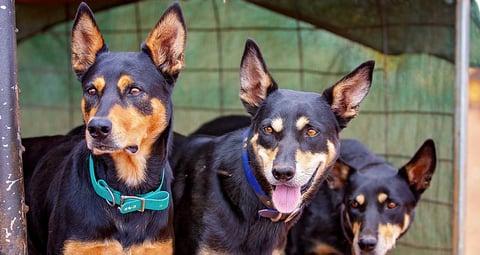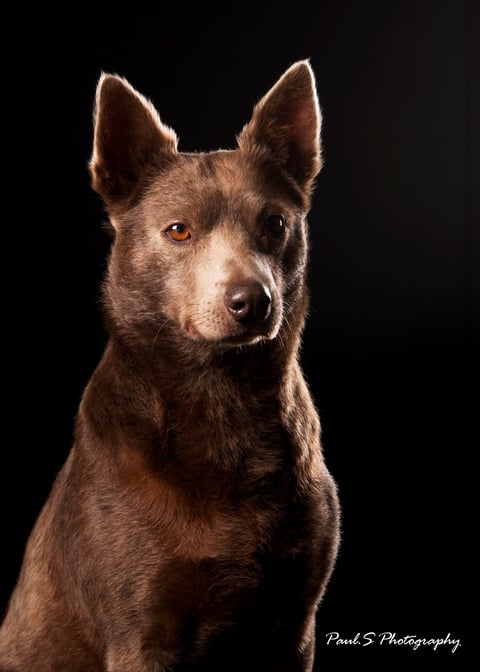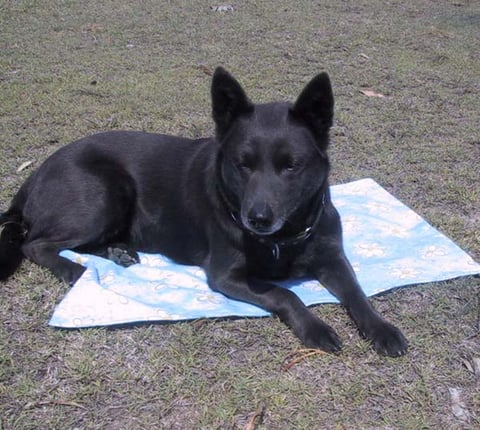Are Kelpies good family pets?
The ABC tv series Muster Dogs placed a spotlight on an iconic Australian breed - the Kelpie, and if we've learnt anything from past film releases such as 101 Dalmatians, Eight Below, Max, and Dog, it's that the breed gets a real popularity boost in the eyes of the pet loving public. There's a few very important things to note though, before you rush out to find a Kelpie or a Belgian Malinois!
These shows and films utilise dogs that are either:
- Animated
- Mature aged and already very highly trained
- Young and under the training of a highly experienced handler
The general public’s love of dogs can blind a lot of people to the actual reality of living with the breed of dog in question.
There is so much to love about the Kelpie, beyond their obvious athletic good looks. But, as a trainer, and owner of two Kelpies, I want to point out what’s good about them, what’s challenging about them, and deliver a healthy dose of reality as to why these dogs are not for everyone.

Photo Credit - Special thanks to Teesh - Pilbara Working Dogs
There's Kelpies, and then there's Kelpies...
The first thing I want to bring to your attention if you don’t already know, is that there are actually two different types of kelpie. The Kelpies in Muster Dogs are what we refer to as working line. The Working Kelpie is bred to work stock animals in the harsh and varied terrain of Australia.
The second type of Kelpie is known as the Australian Kelpie (Show Line or 'Bench' Kelpie). These dogs are found competing in every dog discipline available and excel in agility, obedience, scentwork, tricks and tracking. Show Line Kelpies are smaller in stature than the Working Kelpie. Think Koko from the movie Red Dog. They're most commonly found in solid black or red colouration, and, while still active, they are a little less relentlessly athletic than their working cousins.

Photo: Aekae Teddy Wallace (left), Pilbara Working Dogs (right)
Mandy Sansom, of the renowned Callicoma Kelpies, has been breeding the Australian Kelpie for 23 years and says that the two types of kelpie are becoming more and more distinct with every generation. In terms of appearance, working kelpies are usually two toned, although not always, and are often taller. The ANKC (Australian National Kennel Council) registered kelpies ('Show Line', or 'Australian Kelpies'), are often shorter in height and heavier boned. They tend to be solid coloured, although not always, and the ANKC recognises red, chocolate, black, fawn, blue, red and tan, black and tan. The Working Kelpie Council also registers cream, fawn and tan, and black and tan.
The Australian Kelpies have much more of an off switch, and whilst still a very active dog, they can be taught to relax and be less frantic. When competing in dog sports, they are often more successful than the overactive and highly aroused working kelpies. I find the show bred kelpies have more of a handler focus and ability to concentrate in training and competition than the working lines. I sometimes think the working kelpies have so much energy and so much drive they run faster than their brains allow for and make mistakes. Of course it's a different story when it comes to herding, where this drive and heightened sensitivity to livestock and changing circumstances sees the working kelpies shine. They also have outstanding stamina, having been bred to work all day, every day.

Photo: Tegoura Australian Kelpie (left), Callicoma Midnight Special JDX SPD GD 'Loco' (right)
If you are not a staunch Working Kelpie connoisseur, a show Kelpie can make a really fun suburban pet for someone that just wants a nice compact dog to run and be active with. If you start talking to breeders, make sure they're registered and reputable, and ask about health testing. According to Mandy, the health testing of breeding stock is becoming more and more common amongst ANKC registered breeders of the Australian Kelpie. The most common health testing is hip and elbow x-raying and scoring, to ensure they are not breeding dogs with hip or elbow dysplasia (in fact the breed average is slowly being brought down each year by this wide scale screening). Other health tests available and often utilised by reputable breeders are heart and eye checking (by cardiac and ophthalmic specialists) as well as DNA screening for a number of diseases known to occur in the breed.
The remainder of this post will be focusing on the Working Line Kelpie.
The Working Kelpie
My love affair with the Kelpie began when I was 12 years old. I was gifted a copy of the book Red Dog, and I was so seduced by the story of this Australian legend that I knew one day I would have a Kelpie of my own. That one day was 10 years later, when I got my first Kelpie.
At the time I knew next to nothing about the right questions to ask, and was just excited to finally be making my dream come true. I’d always read how hardy the breed is, and had no idea that these dogs could come with some pretty significant health issues. What a hard learnt lesson that was.
Dog breeds more commonly recognised and bred to be pets are more likely to have stringent health standards that good breeders stick to. They will test parents and resulting litters for various breed specific genetically inherited diseases. The country working dog world has been a little slower on the uptake of genetic health testing. I just so happened to have the misfortune of buying from one such breeder.
I love my dog and wouldn’t trade him for the world, but at a relatively young age he was diagnosed with both Epilepsy and Hip Dysplasia. Prior to Hamlet’s diagnosis, I had no idea just how commonly these conditions occurred in Working Kelpies. These dogs are tough! They are incredibly driven to work, and this drive will often cause them to mask the pain of serious underlying health issues. It is easy for a stock dog breeder to believe that their breeding dogs are completely healthy, simply based on the fact that the dog does not show obvious signs of physical distress while working.
If purchasing one of these dogs, I recommend asking your breeder about their stance on health testing, specifically probing into the health history of the potential parents of your puppy. No one knows these dogs better than the person that lives and works with them day in and day out.
Working dog breeders can vary hugely in the requirements they set for their own personal dogs. This will depend on things like the stock they work and the terrain they work on, this then drives the outcomes of their breedings.
Talking to a Kelpie Breeder
And then there's you..... You have to be honest and upfront about your capabilities so please don’t lie about your past dog experience, and don’t lie about your living circumstances. It's critical that you talk to the breeder about:
- What you are looking for in a dog - helpful hint: this should not include your preferred coat colour.
- The other people and animals the dog will be expected to live with.
- The future purpose you have for it - hobby herder/agility/jogging companion/family pet etc.
- The amount of time and effort you envision being able to devote to the dog.
- You should also ask them a bit about their standards. What factors they are breeding for in terms of working behaviour, temperament, sociability etc.
If you are honest with the breeder, they will be able to identify the puppies in a litter (if any) with average potential for work, and they may be able to accomodate your request for a sport dog or active family companion. However, don’t expect this to happen immediately and don’t be offended if they plainly tell you no. Some people just do not have the current means or motivation to really provide for a working dog, so if a breeder feels you are not a good fit for the dogs they are producing, don’t take it personally. Be grateful if they've been honest because they're trying to do the right thing by you, and importantly, the pup.

Kelpies - already an iconic breed
Kelpies are hugely popular even without the influence of shows like Muster Dogs. If you go to any local shelter or look up private rescue groups on Facebook and there are always kelpies needing rehoming. If your're interested in getting a Kelpie through a rescue, it's always best done with a specialist organisation. Dogs4Jobs are Australia wide and operated by very knowledgeable people who specialise in herding type dogs. They often take in failed working dogs that couldn’t meet the requirements of working life on the farm, and are able to more accurately assess the dogs in their care to be placed in the most compatible homes. If you are a pet person in love with the Working Kelpie, this could be a good avenue for you.
What's the big deal about Kelpies as pets?
There are the people who will say “I had a Kelpie for x amount of years and it was a lazy couch potato”. Be careful who you listen to, and don't dive in blind because the dog you saw on tv was so amazing. Taking on the responsibility of any animal is a significant commitment that should be considered carefully.
Lessons learned living with and training Working Kelpies
1. A kelpie will always perservere a lot longer than you will
Kelpies are bred to have grit and determination like no other. Boy do they love a challenge! It is a long, painful, and often fruitless experience to force a Kelpie to behave the way you want them to.
You must get really good at understanding what motivates your dog, and then manufacturing training scenarios in which your Kelpie thinks the behaviour was their idea in the first place.
2. Physical exercise is overrated
A common misconception about working breeds is that they need heaps of exercise. Sure it has its place in a well adjusted dog, but it is not the be all and end all.
Problem behaviours: Barking? Digging in the garden? Escaping the yard?
Solution: It just needs more exercise. Wrong!
Mental fatigue is so important for these dogs.
If all you do is condition your kelpie to exercise, as the dog matures it becomes more and more difficult to tire it. The dog is constantly switched on and seeking the next thing to do. For any dog, but especially our working Kelpies, we should be spending time early on teaching them how to switch off and cope with periods of boredom.
3. Must love barking
There will be exceptions to every rule, but it is normal for Working Kelpies to bark. This can be made exponentially worse when we factor in their high sensitivity to novelty. Alert barking is not something you will erase completely. However, it pays to spend plenty of time familiarising your dog in a positive way with new and novel experiences while they are young. Teaching them how to be resilient in an ever changing suburban environment will reduce some of the hysteria they might otherwise develop if they feel the need to notify you of every dropping leaf and walking dog in the neighbourhood.
4. Dog Parks and Daycares are not your friend
Ok, so it’s no secret that I have long hated dog parks. I don’t recommend them to anybody. For Working Kelpies this is especially the case.
Working dogs thrive on order and control. They are bred to identify disorder in an environment and bring it under wraps.
5. Kelpies are the ultimate Micromanagers
Anyone who has been to a dog park will know it is hardly an orderly place. For a purpose bred Working Kelpie, this becomes the perfect opportunity to tap into its unfulfilled herding instincts and work the other dogs around it. This is incredibly satisfying for them, and it is often not discouraged by the humans around because “he’s just doing what a herding dog does”. But you guessed it, this can lead to problem behaviour.
When given free reign to “play” this way, with no control or parameters set by the handler, they quickly begin to experience frustration when they go walking on the lead and see dogs on the street that are out of their sphere of influence.
When the leash blocks their access to their usual source of fun, the frustration and arousal can become a frightening combination that leads to many troubling behaviours directed at these other dogs.
6. The relationship takes work
- If you want a dog that will naturally fawn all over you, look elsewhere.
- A bond with one of these dogs is incredibly rewarding, but it does not come cheap.
- They have enough of an independent streak, that they will happily satisfy themselves elsewhere if you are not investing in them
I’m a dog trainer and have been a general Working Kelpie enthusiast for many years. I knew full well what to expect by the time I added my second Kelpie to the mix (thanks Clermont Kelpies).Still, they test me on a personal and professional level every day and I love the challenge, but some days even I just want to pull my hair out. They have certainly made me a better dog handler, but they are not for the faint of heart.
If you’re a normal suburban pet dog owner who has their heart set on a Kelpie and nothing will dissuade you, where to from here?
- Understand that a purpose bred Working Kelpie, the likes of which you see on Muster Dogs, is there to fill a highly specific need.
- These dogs carry their working ability in their very genes and pass these traits on to their offspring.
- In my opinion, at the end of the day very few of these dogs actually make suitable suburban pets, and that is just the honest truth.
- Do some reading up on Show Line versus Working Kelpies. Consider whether one may be better suited to your lifestyle than the other.
- Look into reputable breeders and/or responsible rescue organisations.
- Listen to the professionals around you. Take your time and don’t insist on taking home the first dog/puppy you meet.
- Invest in training straight away.
- Whether you are taking on a puppy or a mature aged dog, herding breeds have behavioural quirks and physical/mental needs that require understanding.
- Get in touch with a qualified dog trainer to help you get off on the right foot with your new dog.
Got questions about the Kelpie? Ask below.

Photo: Pilbara Working dogs (left) Tegoura Australian Kelpie (right)
If you are not a staunch Working Kelpie connoisseur, a show Kelpie can make a really fun suburban pet for someone that just wants a nice compact dog to run and be active with.
Photo Credits - Special thanks to Teesh - Pilbara Working Dogs, Sharryn Lewis Tegoura Australian Kelpies, Mandy Sansom - Callicoma Kelpies




